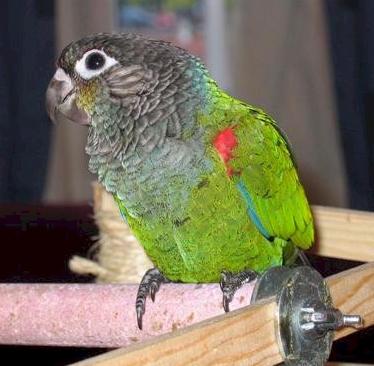Conure - Pearly
Crimson-bellied Conure Scientific Name: Pyrrhura perlata perlata
Fri, 4th April, 2025 - 4:13 pm GMT
Sponsor Ads:

Alternative Name
Crimson-bellied Conure Scientific Name: Pyrrhura perlata perlataBasic Info
Pearly Conures grow to about nine and a half inches in length and weigh about two point eight ounces. Their feet and bills are gray and their irises are brown. Predominantly green in color, Pearly Conures are marked with bright crimson on their abdomens, lower breasts, underwing coverts, and wingbends. Their primary feathers and wing coverts, under tail-coverts and thighs are blue. Also blue tinged, are the forehead and upper wing coverts, and the nape shows a blue band. The underside of the Pearly Conure's tail is gray, while the upperside is dark mahogany red over a green base. On the face, the Pearly Conure shows green tinting all over the lores and upper cheeks, though the lower cheeks are blue. The ear coverts are cream colored, as are the edges of all feathers on the brown head, neck, throat and upper breast. The skin around the periopthalmic ring is white and Pearly Conures have a narrow frontal stripe, which is brownish red in color. They are charming and beautifully colored.
Health
These birds need fresh air and sunlight, but should be sheltered from cold, wind, and rain. Pearly Conures need fresh water at all times. For food, they may be offered a basic seed mix along with fresh food. Provide a variety of fresh foods to prevent your birds from getting bored! Pearly Conures do very well in cages that are two feet by two feet by four feet in dimension. Be sure the cage is extremely sturdy, as Conures are experts at chewing through almost anything! For a nesting box, 17 inches by one foot by eight and a half inches is fine. Most birds enjoy a box with a three-inch outer room, so they can sleep in one "room" and have an observation deck as well! Pearly Conures should be surgically sexed, as they are susceptible to polycystic ovary disease and resulting sterility. Breeding Pearly Conures are quite difficult to breed and prefer to mate in extreme privacy in their nesting boxes. They tend to be infertile. Mating overtures include offering food to the mate, rough-and-tumble play, and fussy nest-box or feather arranging. Generally, the mating season lasts from January to June. Usually, Pearly Conures lay four to six eggs, which incubate for approximately 24 days. Pearly Conure females do all of the egg sitting, and generally will stay in the nest until the chicks are about three weeks old. At around five weeks of age, the chicks will leave the nest and by seven weeks, the parents stop feeding them. The chicks should be hand fostered. They look like adults but have green bellies and duller plumage, along with black irises!Habitat
N/ABehavior
The Pearly Conure is a rare and beautiful Conure. Pearly Conures are native to the jungles of Brazil, where they live in groups or pairs. They enjoy flying and perching high in the forest canopy and subsist on fruits, berries, seeds, nuts and the occasional insect or larva! In captivity, Pearly Conures are just as noisy as they are in the wild! They are intelligent and quite independent, and need lots of toys or chew-items to keep them entertained! Pearly Conures are social animals, and will do well when kept in pairs. They are playful and wildly entertaining! Like all Conures, it is best to keep Pearly Conures in very sturdy cages elevated about five feet from the ground. These birds need fresh air and sunlight, but should be sheltered from cold, wind, and rain. Pearly Conures need fresh water at all times. They need a nest box to sleep and hide in, but also need playtime and affection in proportion with security and privacy!Origin
BrazilHistory
Pearly or Crimson-bellied Conures were first recorded by Spix in 1824. They are native to the upper canopies of the tropical forests of western Brazil. Today, they remain very rare and are hard to breed because there are few original birds, which could be used for breeding. A new breeding program has begun in which Pearly Conures are exchanged between Europe and America, offering a better chance of breeding unrelated birds! There are four subspecies of Pearly Conure.Common Foods
For food, they may be offered a basic seed mix along with fresh food. Provide a variety of fresh foods to prevent your birds from getting bored! Pearly Conures like beans, wheat bread, hibiscus leaves and flowers, brown rice and a variety of fruits and vSponsor Ads:
If you doubt that Rochesterians believe in God, watch how they drive. -- Unknown
Conure - Pearly
Coded by: BGID® | ALL RIGHTS RESERVED Copyright © 2000-2025
Disclaimer | Privacy | Report Errors / Contact | Credits








 Preparing For China. China is growing their military. China Military Technology - can it keep up with the US?
Preparing For China. China is growing their military. China Military Technology - can it keep up with the US?  versus
versus 

 versus
versus 
 This Thread is about the North Korean Military itself - the kind of army, navy, and air force they have.
This Thread is about the North Korean Military itself - the kind of army, navy, and air force they have. 
 versus
versus 
 versus
versus  versus
versus